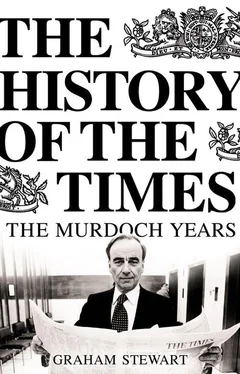Of course, it was not that simple. Even if an existing provincial print works, for example the United Newspapers’ plant in Northampton, could be engaged, there would be a period of disruption – conservatively estimated at six weeks – before The Times could roll out from its new site. Readers’ loyalty had already been seriously tested by the eleven-month shutdown the previous year and another lengthy period in which the paper was off the streets was clearly something to be avoided. More importantly, the strategy assumed that the London print unions would sit back while their jobs were transferred to ‘brothers’ in the provinces. This was not in the spirit of union solidarity. Even if their fellow members in the provinces did decide to handle The Times , the print unions could then hold hostage the Sunday Times by going on strike at Gray’s Inn Road. With this, the whole Thomson strategy of selling the papers together would unwind. Even without these problems, the Rees-Mogg consortium had to convince long-term investors that it could gain access to sufficient and sustainable capital and that a syndicate in which journalists played a part would have the necessary unity of purpose to take hard decisions. [14] John Grigg, The History of The Times , vol. VI: The Thomson Years , p. 554; Evans, Good Times, Bad Times , p. 108; Listener , 30 October 1980.
The consortium’s best hope was to step in following the Thomson board’s failure to attract a serious bid from one of the major media magnates. This Rees-Mogg came to accept, ultimately viewing his plan as a fall-back position, [15] William Rees-Mogg to the author, interview, 3 December 2001.
but at the time the Thomson board watched with mounting alarm as the extent of his desire to promote his rescue plan manifested itself. The Times ’s editor had a journalist’s eye for finding ways to maximize publicity (some supposed that this must have had something to do with the early influence of a theatrical mother). Gathering a television crew about him, Rees-Mogg now set off across the Atlantic. There, he hoped, he might find white knights, ready to take a share in his mission to save ‘this strange English institution’.
Having arrived in the United States, Rees-Mogg had lunch with Katharine Graham, the proprietor of the Washington Post . Despite her liberal politics, she had shown the determination to break a debilitating print workers’ strike that threatened to strangle the Post in 1975, defeating those besieging her printing plant by flying newsprint into it over their heads. Unlike Times Newspapers’ management, she had taken on her industrial tormentors and won. But, joined for lunch by her senior management, even she could not see how The Times could get out of its dire situation. Having listened to Rees-Mogg’s presentation, the verdict was to the point: ‘The Washington Post saw The Times as a potential disaster area which they didn’t want anything to do with,’ Rees-Mogg recalled, ‘although they were very polite and friendly.’ [16] William Rees-Mogg to the author, interview, 3 December 2001.
Rees-Mogg had considered Kay Graham the sort of acceptably independent-minded proprietor The Times should be trying to attract. He had not yet spoken of Rupert Murdoch in that light. Indeed, in 1977 he had told the Royal Commission on the Press: ‘Mr Murdoch’s writ does run in his own building and, much as I respect his energy and vigour, because of his views on the proprietorial function, I would never myself be willing to work for him.’ [17] Quoted in Piers Brendon , The Life and Death of the Press Barons , p. 247.
Less than a month before it was announced The Times was being put up for sale, Rees-Mogg had encouraged his New York correspondent, Michael Leapman, to write an attack on Murdoch’s methods at his New York Post . The article, illustrated with a Post front-page headline ‘PREGNANT MOM IN 911 TERROR’ was equally punchy:
It is nearly four years since Mr Murdoch gave the United States its first true sampling of the journalism of the lowest common denominator. That was when he bought the struggling New York Post and filled its senior editorial positions with British and Australian newspapermen, expert in plumbing the depths of bad taste which Americans had scarcely guessed at. [18] Michael Leapman in The Times , 27 September 1980; Michael Leapman, Barefaced Cheek , p. 190.
Yet now Rees-Mogg made the trip to the top of the New York Post building overlooking the Brooklyn Bridge to discover whether Rupert Murdoch, owner of eighty-four newspapers including the Sun and the News of the World , was interested in helping to save The Times .
The meeting, Rees-Mogg reflected, went well. Murdoch was friendly, courteous and drank not from a mug but from an elegant china tea service. He did not let himself be drawn on exactly what his intentions were but by the time Rees-Mogg returned to Manhattan street level he had gained the impression that Murdoch was sizing up the possibility of a bid for the Sunday Times . This was good, for the whole point of Rees-Mogg’s consortium plan was that there should be a divorce in the Times family. Furthermore, Murdoch appeared to be keen to help the consortium in any practical way, perhaps even printing it at his plant in Worcester. Indeed, ‘he was sympathetic to anything that would keep The Times alive’. [19] William Rees-Mogg to the author, interview, 3 December 2001; Leapman, Barefaced Cheek , pp. 184–6; Evans, Good Times, Bad Times , pp. 96–7.
It was only the third time Murdoch and Rees-Mogg had properly met one another. Previously they had found themselves seated together at a table with the Queen at a celebratory gathering of the Press Club during which Rees-Mogg had noticed the Australian’s ability to make the Queen laugh. But their first meeting, in the summer of 1951, had been more prescient. The young Rees-Mogg, already at the age of twenty-three bearing the assumed gravitas of an elder statesman, had been walking up The Turl in Oxford when he was stopped by a ‘brash young member of the Labour Club’ who wanted to cut him in on a business venture. The Antipodean undergraduate said he was thinking of buying the ailing student newspaper Cherwell , and wondered whether Rees-Mogg wanted to invest in his scheme. Venerable title or not, Rees-Mogg replied that Cherwell was staid and boring and would never attract sufficient advertising to be an attractive business proposition. The young Murdoch countered that with drive and initiative it could be made attractive by changing the editorial content, bringing it up to date and transforming the finances. ‘You’ll never make any money out of Cherwell ’ was the young Rees-Mogg’s cheerful reply. And with that mistaken prophecy, the two undergraduates went their separate ways. [20] William Rees-Mogg to the author, interview, 3 December 2001; William Rees-Mogg in Independent , 29 October 1990.
Twenty-nine years later, two men were determined to put Murdoch’s profit-making expertise back in touch with a venerable, occasionally staid, loss maker. The first was one of Fleet Street’s most respected figures – Sir Denis Hamilton, editor-in-chief of Times Newspapers Limited. The other was Sir Gordon Brunton, managing director of TNL’s parent company, Thomson British Holdings Limited. Both men thought Rees-Mogg’s consortium idea was suicidal, but when they had discussed the disposal of Times Newspapers in a secretly convened meeting with Thomson’s chairman, Lord Thomson of Fleet, on 18 September 1980, Hamilton had reported the opinion that ‘Rupert Murdoch is probably not interested’. [21] Minutes of ad hoc committee on TNL, Thomson British Holdings Ltd, 18 September 1980. Hamilton Papers 9758/4.
One look at the other likely bidders was enough to convince those seated around the table that it was a matter of urgency to get him interested.
Читать дальше












